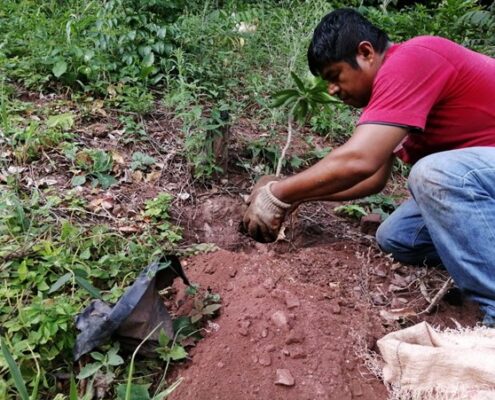 https://greenmarked.it/wp-content/uploads/2023/10/Cattura.jpg
957
1440
Sarah Santos Ferreira
https://greenmarked.it/wp-content/uploads/2022/01/LOGO-GREENMARKED-SITO-600x600.png
Sarah Santos Ferreira2023-10-16 21:33:112023-10-17 10:02:14Eyes on Fire
https://greenmarked.it/wp-content/uploads/2023/10/Cattura.jpg
957
1440
Sarah Santos Ferreira
https://greenmarked.it/wp-content/uploads/2022/01/LOGO-GREENMARKED-SITO-600x600.png
Sarah Santos Ferreira2023-10-16 21:33:112023-10-17 10:02:14Eyes on FireNovember 21, 2023

Brazil is grappling with an unprecedented heatwave and water scarcity, particularly in the Northern region, where the Caatinga biome, a unique ecosystem, is undergoing desertification for the first time. Here, local communities are strongly affected by these events. How is the climate crisis reshaping Brazilian lands and communities?
Brazilian Heat
Brazil has been experiencing unprecedented heatwaves, with the thermal sensation reaching a staggering 52 degrees Celsius at Rio de Janeiro this week [1]. This extreme temperature, unheard of in the country’s history, has posed significant challenges to the population and the environment.
In response to the soaring temperatures, Brazilians have been advised to take several safety measures, with hydration being paramount. Drinking plenty of water helps regulate body temperature and prevent heat-related illnesses. However, access to clean drinking water is not universal across the country.
Water Access: A historical challenge in the Northern region
While hydration is a crucial safety measure, not all Brazilians have equal access to water. This is especially true for the Northern region of the country, where water scarcity is a significant issue. Many communities in this region struggle with inadequate water supply, affecting their ability to cope with the heatwave.
To address this issue, several programs have been initiated to guarantee water to the population [2]. These programs aim to improve water infrastructure, increase the availability of clean drinking water, and promote sustainable water management practices. Despite the challenges, these initiatives represent a beacon of hope for many communities.

Fig.1: Caatinga in Paraíba (Jaime Dantas. Paraíba, November 10 2020). Source: Unsplash.com
Caatinga: A unique ecosystem under threat
Located in the interior northeastern part of Brazil, Caatinga is a unique ecosystem characterized by semi-arid tropical vegetation. It covers 850,000 km², nearly 10% of Brazil’s territory. The name “Caatinga” is a Tupi word meaning “white forest” or “white vegetation”. The Caatinga is a xeric shrubland and thorn forest, which consists primarily of small, thorny trees that shed their leaves seasonally. Cacti, thick-stemmed plants, thorny brush, and arid-adapted grasses make up the ground layer. Most vegetation experiences a brief burst of activity during the three-month-long rainy season [3].
Despite its resilience, the Caatinga biome is now facing a significant threat – desertification. This process of environmental degradation is common in arid, semi-arid, and dry sub-humid areas under climate change. In Brazil, 62% of the areas susceptible to desertification were originally occupied by this biome many of which have already been significantly altered [4].
Impact on Local Communities
The desertification of the Caatinga biome has a profound impact on the local communities that inhabit this region. These communities, primarily composed of smallholder farmers, rely heavily on the land for their livelihoods. They practice dry farming and cattle raising, and there is also a great dependency on forestry products.
The desertification process directly affects these communities, particularly those that depend on agriculture and livestock for their survival. The transformation of the biome into a desert environment results in a decline in vegetation productivity, which in turn impacts agricultural output. This environmental change also increases the climatic vulnerability of the affected regions, making them more prone to climatic changes that affect all segments of society: from the agricultural industry to the trade, service, and industrial sectors.
The ongoing environmental changes in Brazil, particularly the desertification of the Caatinga biome, pose significant challenges for the local communities. These changes not only threaten the unique biodiversity of the region but also jeopardize the livelihoods of millions of people who depend on this land. It underscores the urgent need for comprehensive climate action and sustainable water management strategies in Brazil. The resilience of these communities and the future of this unique biome depend on our collective ability to mitigate these environmental changes and adapt to a new climate reality.
This article is part of the project “PILLOLE D’ACQUA PIANA: seminari itineranti, blog e podcast per una gestione sostenibile delle risorse idriche in Piana Rotaliana” carried out by ECONTROVERTIA APS and supported by Fondazione Caritro (Prot. no. U445.2023/SG.386 of April 23, 2023).

ARTÍCULOS RELACIONADOS:
REFERENCIAS:
[1] Redação, Nexo Jornal (2023). Ondas de calor aumentaram de 7 para 52 dias no Brasil | Nexo Jornal Retrieved on 16 November 2023, from https://www.nexojornal.com.br/extra/2023/11/13/Ondas-de-calor-aumentaram-de-7-para-52-dias-no-Brasil
[2] Water organization. Water means life. Retrieved on 16 November 2023 https://water.org/our-impact/all-stories/water-means-life/
[3] Wikipedia. Caatinga. Retrieved on 16 November 2023 https://en.wikipedia.org/wiki/Caatinga
[4]Center for Environmental Peacebuilding. The Caatinga biome. Retrieved on 16 November 2023 https://cepb.ngo/the-caatinga-biome/
Cover and Preview image: Fan outdoors. Kalamata, May 24, 2020. Free-source photo by George Chandrinos en Unsplash.com










